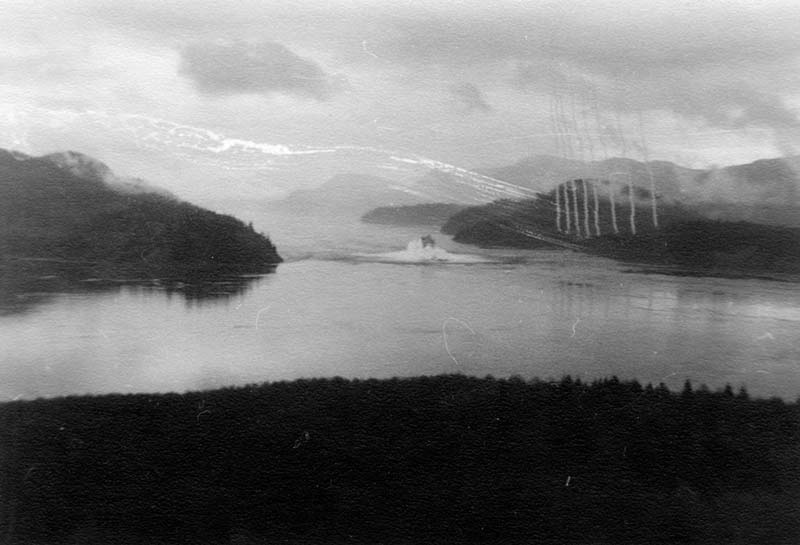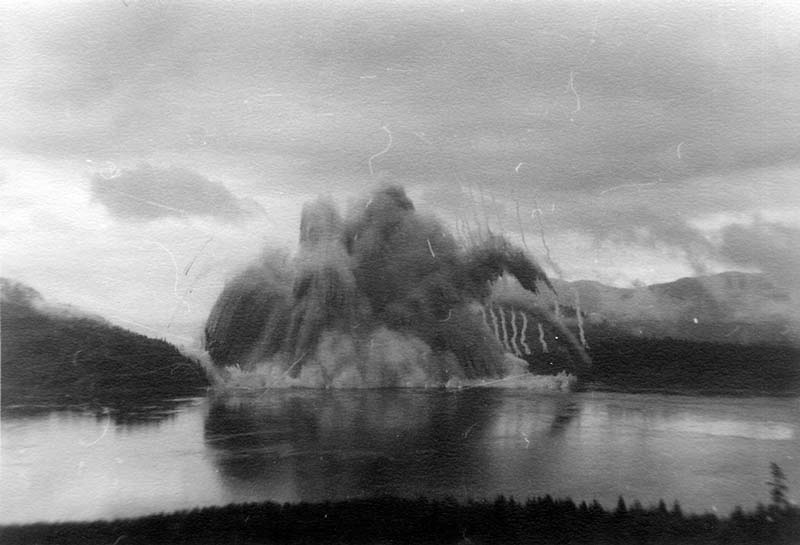
Aerial view of Ripple Rock in 1957. Note the large, turbulent eddies that formed in its wake during low tide.[Wikipedia]
Consulting engineer for the Ministry of Public Works, Dolmage would do just that at 9:31 a.m. One-fifth of a second later, more than half a million tonnes of rock, water and debris would shoot 300 metres into the air, creating one of the largest non-nuclear explosions ever.
Marking its 65th anniversary, this event was none other than the explosion of Ripple Rock, an underwater twin-peaked mountain in North Vancouver’s Seymour Narrows, which became a notorious ship killer.
The rock’s location in the middle of a tight waterway, which functioned as the Granville Street of maritime shipping and travel routes, gave captains pause as they planned their journey through.
“Ripple Rock sets up…every form of turbulence known to nautical science.”
From 1945-1955 about 150,000 travellers, 2,000 freighters and 7,000 tugs, barges and small craft passed through this watery channel.
Ripple Rock’s peaks were never deep, especially at low tide when there would only be about three metres of clearance. The passage was also known for its hazardous waves and whirlpools, which were more likely because of the bi-directional tidal currents. This left ships about 20-40 minutes, twice a day, to pass through the claustrophobic stretch safely.
“Ripple Rock sets up…every form of turbulence known to nautical science,” Maclean’s wrote.
Kat Eschner, writing in Smithsonian Magazine, also noted: “Add a large, jagged underwater rock…and you have a recipe for shipwrecks.”
During its reign in Seymour Narrows, Ripple Rock damaged or sank more than 120 vessels and took 114 lives.
The USS Saranac crashed into Ripple Rock in 1875 and the Royal Navy’s Satellite would do the same almost a decade later. Luckily, however, the crews made it out unscathed.
“[We got] caught in the swirling torrent of Seymour Narrows like a chip in a gutter,” midshipman Bertram M. Chambers wrote.
Plans to destroy that stubborn rock soon began to circulate; however, it would take almost half a century before they came to fruition.
It was only after Vancouver and Victoria went head-to-head over what should be done about the underwater peak during the 1940s that serious political talk about destroying it was made.
While Vancouver was ready to say its goodbyes to Ripple Rock, Victoria thought the rock could be used to prop up a railway connection between Vancouver Island and the mainland.
Ultimately, the U.S. would end the debate when its navy requested Canada destroy the rock out of concerns for the safety of their ammunition ships heading to Alaska. Soon, the Canadian government put plans in place to purify what George Vancouver deemed the “vilest” stretch of water in the entire world—by destroying Ripple Rock.
But it would take a couple of attempts before the goal was reached.

The blast breaches the water’s surface immediately following detonation.[Wikipedia]
“I am disgusted with Ripple Rock…Let somebody else deal with it for a change.”
In 1943, plans to use floating drill barges and explosives to break up the rock were cut short when their cables continually snapped after 48 hours.
In 1945, drilling barges were traded in for two 1,097-metre-long steel lines that allowed demolition workers to drill holes into the rock and fill them with explosives.
But when only 93 out of the 1,500 explosions were effective, the staff commissioned to destroy this hearty rock became fed up, thereby letting a decade pass before they would confront it one last time.
“I am disgusted with Ripple Rock,” Public Works Minister Alphonse Fournier told the House of Commons. “Let somebody else deal with it for a change.”
Finally, from 1955-1958, a 75-man crew built four shafts, one of them 152 metres long from Maud Island and another 722 metres from Ripple Rock’s base.
After filling the rock with 1,400 tonnes of explosives, nearly 10 times more than what would have been required if Ripple Rock had been above water, rumours from the surrounding community started to run wild.

Debris are ejected as a cloud of dust expands across Seymour Narrows.[Wikipedia]
Some even went so far as to claim that the explosion would trigger the beginning of the “big one,” an earthquake that would break British Columbia off from the rest of Canada.
Thankfully, the explosion’s aftermath was nothing more than a few rumbles and some unlucky fish.
Still, the Ripple Rock blast was a marvel of modern engineering and one of the first events to be broadcast across Canada, marking its own immortality in the nation’s consciousness.
“Like a veteran performer…Old Man Ripple Rock staged a death scene today that was truly memorable,” wrote a reporter for the Victoria Times Colonist.
“Out of the fatal, cataclysmic blow came incredible beauty.”
Advertisement





















